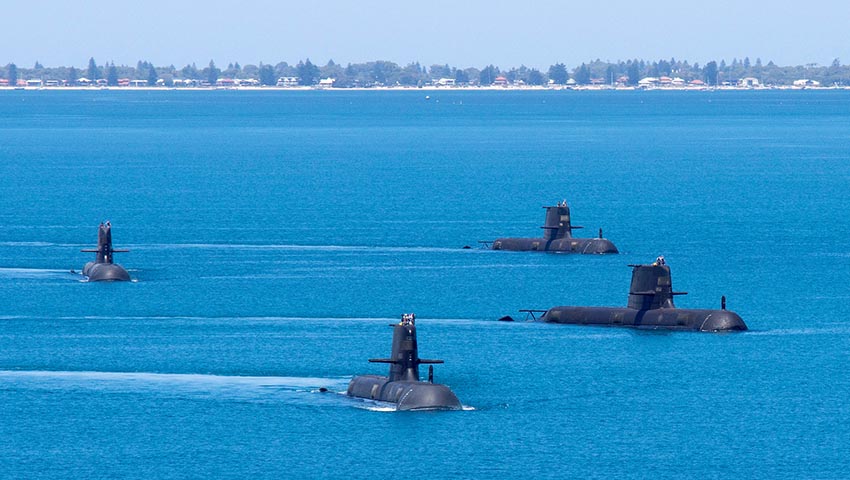Opinion: Former naval officer and defence industry analyst Chris Skinner refutes the notion that defence must choose between crewed or uncrewed vehicles.
To continue reading the rest of this article, please log in.
Create free account to get unlimited news articles and more!
Learned colleagues were surprised when I objected to their treating crewed submarines, nuclear or conventional, as superior to autonomous uncrewed vehicles (AUV) which have been in the news a lot lately.
My emphatic differentiation was based on the fundamental premise that an AUV, no matter how far developed the artificial intelligence (AI) and machine learning (ML) that is embodied, there is still an inherent limitation of historical conceptual thinking that does not constrain highly intelligent human command, sensory or weapons operators.
The central issue with human capability is the ability to imagine and to investigate phenomena that have not been previously encountered and are therefore absent from any big data resource which is essential to ML and AI. Submarine command teams can surprise an enemy by acting in unexpected ways, based on long experience and judgment of an adversary and of the battle-space environmental conditions. Sensor operators become steeped in the look and feel of their domain and will note the minutest new phenomenon and investigate and interpret it until a conclusion can be drawn. This will be a human conclusion that no machine can produce.
But this is not to say that AUVs are anything but a vital augmentation to our maritime capability in the undersea domain. We need them urgently and we need lots of them. To carry out the repetitive tasks in deeper and more hazardous circumstances than a crewed submarine can do. And at much less cost in either acquisition or in sustainment, and with only a modest overhead of additional investment to handle the preparation, tasking, deployment, recovery, and refurbishment of the AUV.
Another challenge that applies to both crewed and uncrewed vehicles is command, control and communications and that presents both an opportunity and a challenge from the discontinuous comms with any undersea capability while wholly submerged. This also affects the operation of AUVs in coordinated operations, whether just a few of them or a larger number where individual behaviour is less important than that of the collective behaviour of the swarm.
There is a trade-off to be performed here that Australia is ideally positioned to undertake in parallel with the Nuclear Powered Submarine Task Force and other AUKUS initiatives. The trade-off should look at the overall undersea domain and tabulate the various capability that we derive from SSN, AUV and static or wire-guided undersea capabilities. The operational depth, speed, endurance, cost of ownership (acquisition, infrastructure and other investments, sustainment, disposal), workforce requirements, other risk factors, domestic industry potential and so on should all be compared and a range of optimum solutions determined. Then the market should be tested for rapid acquisition of a heterogenous array of capabilities that will undoubtedly include both crewed submarines and AUVs of various kinds.
The key point that I made to my colleagues is that this should not be seen as a choice of alternatives. Rather it is an optimisation process to determine the most cost-effective mix. And that is doable and will also provide some great opportunities for further development of local industry to cover those capabilities as is already starting to happen with the “Ghost Bat” (formerly Loyal Wingman) uncrewed aerial vehicle (UAV) and the recently announced SeaWolf project, a 12-metre autonomous underwater vessel developed in concert with Cellula Robotics.
Elsewhere we note accelerated acquisition programs of extra-large uncrewed undersea vehicles [XLUUV] such as the Boeing Orca, all with flexible payload space and power capacity for extended duration tasks limited only by the planning and deployment capacity of the operating unit.
For Australia, we have an enormous maritime domain and total dependence on maritime trade by air and sea. There is clearly a task to know what is happening within this activity and to respond to intrusions and threats to our national and regional security. We need a large number of autonomous vehicles to undertake the routine and time and space-consuming tasks of surveillance and investigation of these domains, and we need specialised and high-capability crewed platforms to undertake the selective response to anomalies detected and investigated by our autonomous uncrewed assistants.
So in the very much needed force structure review to be undertaken this year by our new government we should look in the various domains and especially in the undersea domain for a combined approach that identifies the range of combinations of crewed and uncrewed autonomous platforms to perform a range of tasks, then to be optimised for local industry involvement, cost of ownership, required workforce and other factors.
And let’s stop the futile discussion of whether we should choose between crewed and uncrewed capabilities.
Cristopher Skinner served 30 years in the Royal Australian Navy as a Weapons and Electrical Engineering Officer in six surface warships, in the South-East Asian Treaty Organisation, the Vietnam War and surveillance of the North-West Indian Ocean. In two of these ships, he was the action Weapons Control Officer for ASMD and AAW watchkeeper for area air defence dealing with engagement decisions in real time. Shore service included secondment to the Defence Research Centre, Salisbury, the US Naval Sea Systems Command to manage the lead-ship trials for a joint frigate project and the initial project director for the ANZAC frigate program of 10 ships for Australia and New Zealand. He is a member of several naval and geopolitical institutes, but the opinions expressed here are his own.

 Login
Login







